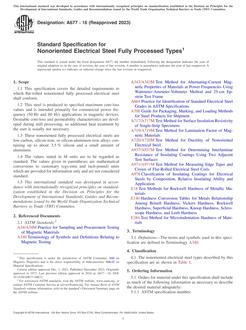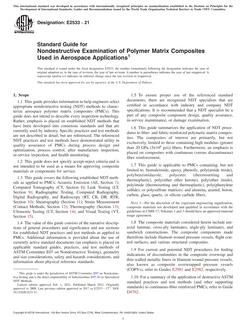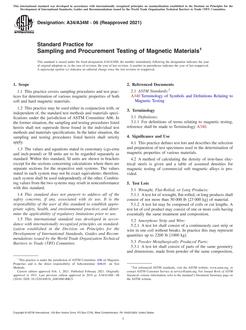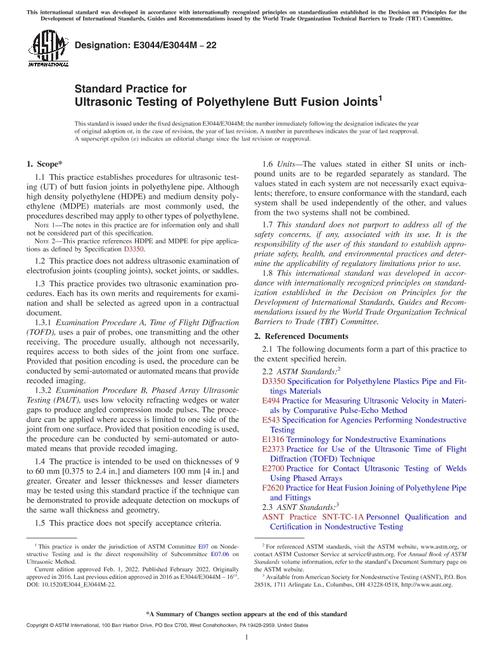-
-
Available Formats
- Options
- Availability
- Priced From ( in EUR )
-
Available Formats
-
- Immediate download
- €55.05
- Add to Cart
-
- Printed Edition
- Ships in 1-2 business days
- €55.05
- Add to Cart
Customers Who Bought This Also Bought
-

ASTM A677-16(2023)
Priced From €57.80 -

ASTM E2533-21
Priced From €75.23 -

ASTM A34/A34M-06(2021)
Priced From €42.20 -

ASTM A343/A343M-14(2019)
Priced From €49.54
About This Item
Full Description
1.1''This practice establishes procedures for ultrasonic testing (UT) of butt fusion joints in polyethylene pipe. Although high density polyethylene (HDPE) and medium density polyethylene (MDPE) materials are most commonly used, the procedures described may apply to other types of polyethylene.
Note 1:''The notes in this practice are for information only and shall not be considered part of this specification.
Note 2:''This practice references HDPE and MDPE for pipe applications as defined by Specification D3350.
1.2''This practice does not address ultrasonic examination of electrofusion joints (coupling joints), socket joints, or saddles.
1.3''This practice provides two ultrasonic examination procedures. Each has its own merits and requirements for examination and shall be selected as agreed upon in a contractual document.
1.3.1''Examination Procedure A, Time of Flight Diffraction (TOFD), uses a pair of probes, one transmitting and the other receiving. The procedure usually, although not necessarily, requires access to both sides of the joint from one surface. Provided that position encoding is used, the procedure can be conducted by semi-automated or automated means that provide recoded imaging.
1.3.2''Examination Procedure B, Phased Array Ultrasonic Testing (PAUT), uses low velocity refracting wedges or water gaps to produce angled compression mode pulses. The procedure can be applied where access is limited to one side of the joint from one surface. Provided that position encoding is used, the procedure can be conducted by semi-automated or automated means that provide recoded imaging.
1.4''The practice is intended to be used on thicknesses of 9 to 60 mm [0.375 to 2.4 in.] and diameters 100 mm [4 in.] and greater. Greater and lesser thicknesses and lesser diameters may be tested using this standard practice if the technique can be demonstrated to provide adequate detection on mockups of the same wall thickness and geometry.
1.5''This practice does not specify acceptance criteria.
1.6''Units'''The values stated in either SI units or inch-pound units are to be regarded separately as standard. The values stated in each system are not necessarily exact equivalents; therefore, to ensure conformance with the standard, each system shall be used independently of the other, and values from the two systems shall not be combined.
1.7''This standard does not purport to address all of the safety concerns, if any, associated with its use. It is the responsibility of the user of this standard to establish appropriate safety, health, and environmental practices and determine the applicability of regulatory limitations prior to use.
1.8''This international standard was developed in accordance with internationally recognized principles on standardization established in the Decision on Principles for the Development of International Standards, Guides and Recommendations issued by the World Trade Organization Technical Barriers to Trade (TBT) Committee.
Document History
-
ASTM E3044/E3044M-22
currently
viewing
Standard Practice for Ultrasonic Testing of Polyethylene Butt Fusion Joints- Most Recent
-
ASTM E3044/E3044M-16e1
Standard Practice for Ultrasonic Testing of Polyethylene Butt Fusion Joints- Historical Version
-
ASTM E3044/E3044M-16
Standard Practice for Ultrasonic Testing of Polyethylene Butt Fusion Joints- Historical Version





